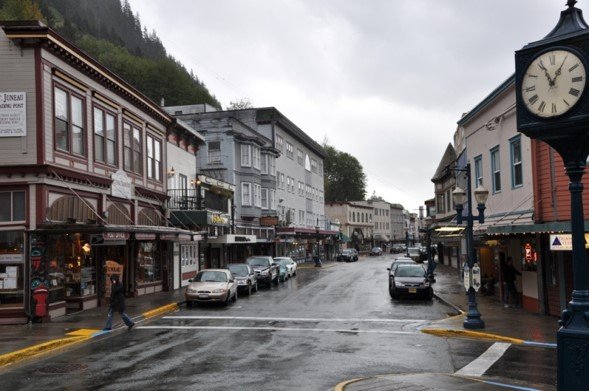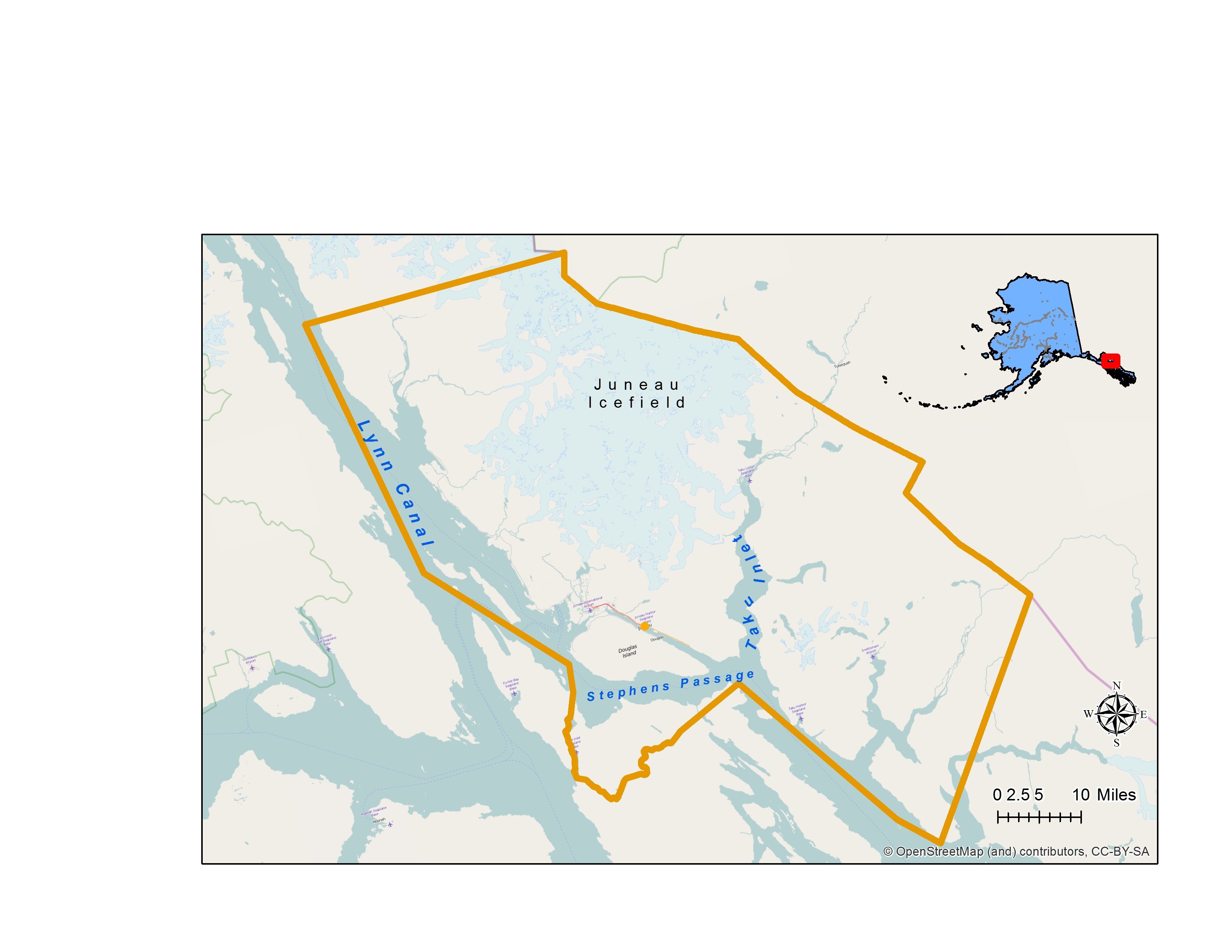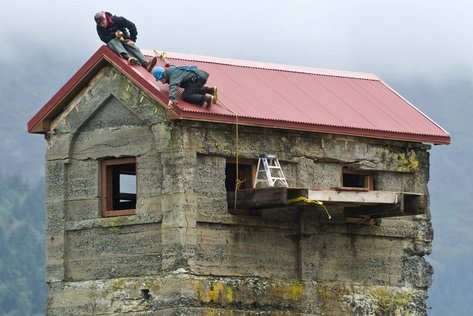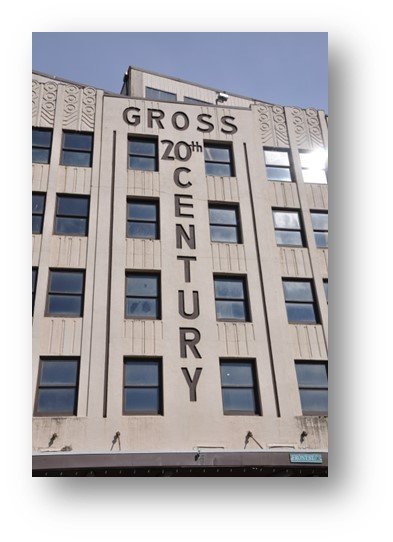City and Borough of Juneau
Unified Home Rule Borough
2022 Population: 32,202
Size: 2716.70 sq. miles
Historic Resources Advisory Committee (HRAC):
HRAC is a body of nine members of the community, appointed by the CBJ Assembly, which monitors the historic and cultural resources within the City and Borough of Juneau. The HRAC is comprised of the following: archaeologists, historians, architects, people knowledgeable in the customs and language of the Tlingit and Haida People, owners of locally recognized historic property, people familiar with the operations and issues relating to the city museum, teachers, and the general public.
The Committee's duties include, reviewing and making recommendations about local projects that might affect properties identified in the local historic preservation plan; reviewing and developing nominations to the National Register of Historic Places; and to cooperate and consult with the Assembly, the Planning Commission, and the Alaska State Historic Preservation Officer on matters concerning historical districts and historic, prehistoric, and archaeological preservation.
 Commission Website
Commission Website
Historic Property Inventory
Design Guidelines
Alaskan Community Profile

-
CLG Grants

Historic Preservation Planning Grants
Historic Preservation Plan, Phase 1. 2015; Phase II, 2017.
Juneau Memorial Building Use and Preservation Plan. 2012.
Juneau Downtown Historic District Design Standards Evaluation. 2005, 2006, 2007.
Historic/Cultural Preservation Plan. 1995, 1996.Survey and Inventory Grants
Treadwell Mining Complex Historic Properties Study. 2009.
Historic Preservation Database. 2008, 2010.
Merchant's Wharf Historical Survey: Historic Property Evaluation of the Alaska Coastal Airlines Hangar
Perseverance Trail Survey, Last Chance Basin to Silver Bow Basin. 2003.
Historic Building Survey of the Casey-Shattuck Neighborhood. 2000, 2003.
Historic Cemeteries in Douglas, Alaska. 1994.
Inventory and Survey of Historic Shipwrecks. (6) 1991.
Chicken Ridge Neighborhood Historic Building Survey. 1991
Report of the Treadwell Historic Resources Survey. 1990.
Report of the Juneau Dairy Farming Historic Resources Survey. 1990.
Historic Structures Report for Jualpa Mine Camp of the Alaska Juneau Gold Mining Company. 1989.
Douglas Townsite Historic Building Survey. 1988.
Juneau Townsite Historic Building Survey. 1987.National Register of Historic Places Grants
Juneau Memorial Library Nomination. 2004
Historic Cemeteries of Juneau and Douglas, Alaska. 1996.
Chicken Ridge National Register Nomination. 1992.Historic Preservation Development/Predevelopment Grants
Alaska-Juneau Gold Mine Power Towers. 2014.
Salt Water Pump House Stabilization. 2013.
Stabilization of Historic Structures at Jualpa Mine Camp Historic District. 1994, 1995, 1996, 1997, 1999, 2001, 2002, 2006.Historic Preservation Education Grants
Treadwell Mine Interpretive Panels, 2017.
Evergreen Cemetery Inventory and Interpretation. 2014.
Treadwell Mine Signs and Interpretive Shelter. 2012.
Treadwell and Jualpa Mines Interpretive Signs. 2010.
Downtown Juneau Interpretive Signs. 2005.
Interpretive Signs for Traditional Places. 2001.
Historic Preservation Web Page. www.juneau.lib.ak.us/history/ 1998, 2000.Commission Training Grants
National Alliance of Preservation Commissions Forum, 2015, 2017.
Local Historic Preservation Commission Training. 2009, 2012.
National Alliance of Preservation Commissions Forum. 1999, 2005, 2008, 2014.
CLG Workshop. 2000.
Economic Perspectives: Making the Historic Preservation Connection Workshop. 1993, 1994.
-
A Brief History
-
The Auke Tlingit had fish camps at the mouths of the streams that are now part of the City and Borough of Juneau. In 1880, nearly twenty years before the Klondike gold discovery, Auke Chief Kowee led Joe Juneau and Richard Harris to Gold Creek where they found gold. A camp quickly was established that became the town of Juneau. Hard rock gold was found across the channel in 1882, and the Treadwell Mine employed 2,000 people, and produced $66 million in gold in its 35 years of operation. More hard rock discoveries followed, and the Alaska-Juneau Mine on the mainland became the largest of its kind in the world, producing over $80 million in gold before it closed in 1944.
Juneau quickly became larger than Sitka and advocated to become Alaska's political center. The City of Juneau was one of the first to incorporate after Congress passed legislation in 1900. The legislation called for the government offices to move from Sitka to Juneau, but the physical move did not happen until 1906. The acts that made Alaska a territory in 1912 and a state in 1959 named Juneau as the capital. After Congress created the Tongass National Forest in 1909, the Forest Service established its regional office at Juneau and much surrounding land became part of the forest, including Mendenhall Glacier, already a popular visitor attraction.
Along with mining and government, fishing, a sawmill, trading, professional services, and tourism helped Juneau be Alaskas largest city in population between 1910 and 1950. The geography offered little flat land, so mine tailings were used to make level areas along the waterfront for buildings. Native people continued to live near the mouth of Gold Creek. Juneau and Douglas became home to Japanese, Filipinos, and other Asian-Americans who worked in the fisheries and opened small businesses.
After Alaska became a state in 1959, a number of new government buildings for federal, state, and city offices were built. Along with government, Juneau is a major destination on Alaskas scenic Inside Passage for cruise ships five months of the year. In 1970 the City of Juneau, City of Douglas, and Greater Juneau Borough unified as the City and Borough of Juneau. The community was one of the first to see potential historic districts with its downtown business district and earliest neighborhoods.
-
-
National Register of Historic Places Listings

Alaska Governor's Mansion
716 Calhoun St.
Alaska Steam Laundry
174 S. Franklin St.
Alaskan Hotel
167 S. Franklin St.
Bergmann Hotel
434 3rd St.
Chicken Ridge Historic District
Seventh, Goldbelt, Dixon, and Basin Sts.
Davis, J. M., House
202 6th St.
Frances House
137 6th St.
Fries Miners' Cabins
500 block, Kennedy St.
Gruening, Ernest, Cabin
Mile 26, Glacier Hwy.
Holy Trinity Church (Original church was completely destroyed by fire in late 2005/early 2006)
325 Gold St.
Jualpa Mining Camp
1001 Basin Rd.
Juneau Downtown Historic District
Franklin, Second, First, and Front Sts.
Juneau Memorial Library
114 W. Fourth St.
MacKinnon Apartments
236 Third St.
Mayflower School
St. Ann's and Savikko Sts., Douglas
Point Retreat Light Station
N. end of Admiralty Island
Sentinel Island Light Station
Sentinel Island
St. Nicholas Russian Orthodox Church
326 5th St.
Twin Glacier Camp
Taku River
Valentine Building
202 Front St.
Wickersham House
213 7th St.
Fort Durham Site
Address Restricted
X'unáxi
Address Restricted
